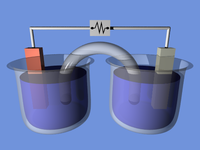
Photo from wikipedia
Most electrochemical reactions require delivery of protons, often from water, to surface-adsorbed species. However, water also acts as a competitor to many such processes by directly reacting with the electrode,… Click to show full abstract
Most electrochemical reactions require delivery of protons, often from water, to surface-adsorbed species. However, water also acts as a competitor to many such processes by directly reacting with the electrode, which necessitates using water in small amounts. Controlling the water content and structure near the surface is an important frontier in directing the reactivity and selectivity of electrochemical reactions. Surfactants accumulate near surfaces, and therefore, they can be used as agents to control interfacial water. Using mid-IR spectro-electrochemistry, we show that a modest concentration (1 mM) of the cationic surfactant CTAB in mixtures of 10 M water in an organic solvent (dDMSO) has a large effect on the interfacial water concentration, changing it by up to ∼35% in the presence of an applied potential. The major cause of water content change is displacement due to the accumulation or depletion of surfactants driven by potential. Two forces drive the surfactants to the electrode: the applied potential and the hydrophobic interactions with the water in the bulk. We have quantified their competition by varying the water content in the bulk. To our knowledge, for the first time, we have identified the electrochemical equivalent of the hydrophobic drive. For our system, a change in applied potential of 1 V has the same effect as adding a 0.55 mole fraction of water to the bulk. This work illustrates the significance of surfactants in the partitioning of water between the bulk and the surface and paves the way toward engineering interfacial water structures for controlling electrochemical reactions.
Journal Title: Journal of the American Chemical Society
Year Published: 2023
Link to full text (if available)
Share on Social Media: Sign Up to like & get
recommendations!